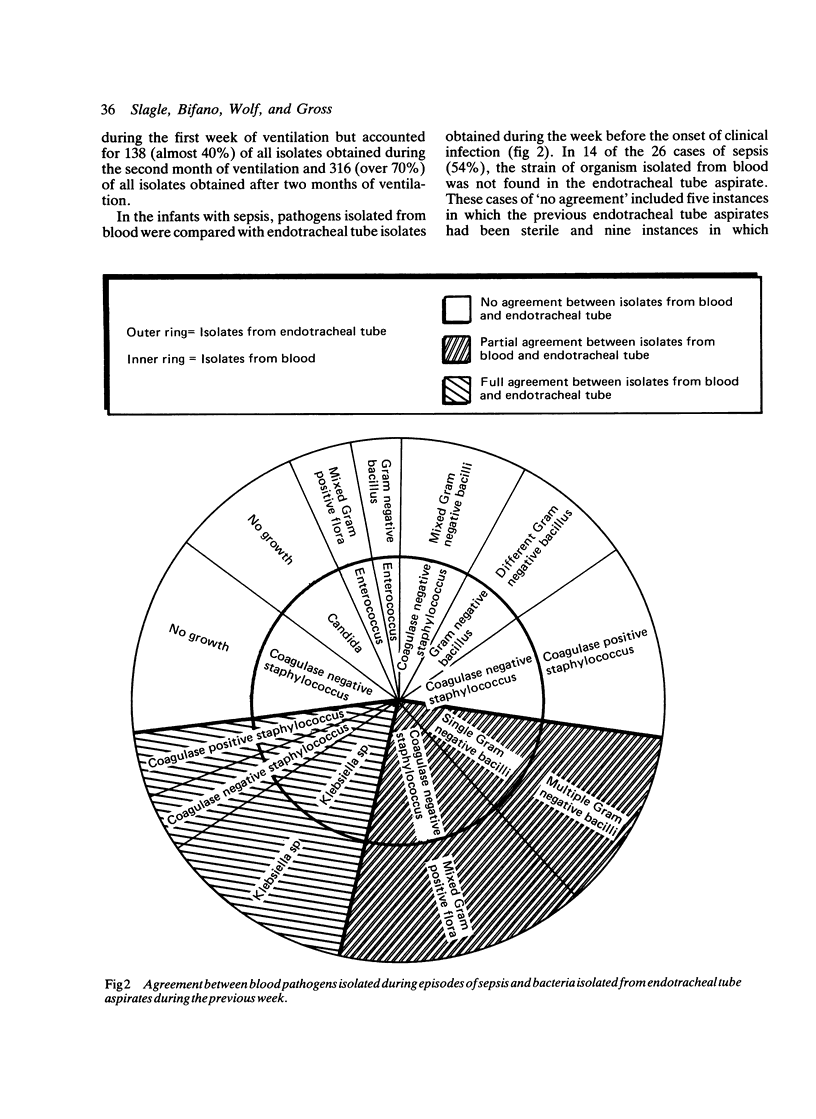Abstract
Serial cultures of endotracheal tube aspirates were carried out in 94 neonates who were intubated and had been ventilated for longer than one week. A similar change in bacterial colonisation with duration of ventilation was seen in infants who subsequently developed sepsis and those who did not. In both groups, 177 aspirates (more than 90%) obtained during the first week of ventilation were sterile. Thereafter, colonisation with mixed Gram positive flora emerged followed by growth of Gram negative bacilli. For the infants who developed sepsis, the correlation between pathogens isolated from blood during the episodes of sepsis and those from previous endotracheal tube isolates was poor; in only five of the 26 cases of sepsis (19%) was the same single strain of organism isolated from culture of the blood and of the endotracheal tube aspirate. Other markers of infection such as endotracheal tube aspirate white blood cell counts and changes in bacterial flora were not useful in predicting systemic infection. Routine surveillance cultures of endotracheal tube aspirates in ventilated infants are not helpful in predicting the pathogens that are isolated from the blood during episodes of sepsis.
Full text
PDF




Selected References
These references are in PubMed. This may not be the complete list of references from this article.
- Brook I., Martin W. J., Finegold S. M. Bacteriology of tracheal aspirates in intubated newborn. Chest. 1980 Dec;78(6):875–877. doi: 10.1378/chest.78.6.875. [DOI] [PubMed] [Google Scholar]
- Evans M. E., Schaffner W., Federspiel C. F., Cotton R. B., McKee K. T., Jr, Stratton C. W. Sensitivity, specificity, and predictive value of body surface cultures in a neonatal intensive care unit. JAMA. 1988 Jan 8;259(2):248–252. [PubMed] [Google Scholar]
- Fulginiti V. A., Ray C. G. Body surface cultures in the newborn infant. An exercise in futility, wastefulness, and inappropriate practice. Am J Dis Child. 1988 Jan;142(1):19–20. doi: 10.1001/archpedi.1988.02150010029014. [DOI] [PubMed] [Google Scholar]
- Gregory G. A. Respiratory care of newborn infants. Pediatr Clin North Am. 1972 May;19(2):311–324. doi: 10.1016/s0031-3955(16)32702-x. [DOI] [PubMed] [Google Scholar]
- Harris H., Wirtschafter D., Cassady G. Endotracheal intubation and its relationship to bacterial colonization and systemic infection of newborn infants. Pediatrics. 1976 Dec;58(6):816–823. [PubMed] [Google Scholar]
- Sherman M. P., Chance K. H., Goetzman B. W. Gram's stains of tracheal secretions predict neonatal bacteremia. Am J Dis Child. 1984 Sep;138(9):848–850. doi: 10.1001/archpedi.1984.02140470048015. [DOI] [PubMed] [Google Scholar]
- Sherman M. P., Goetzman B. W., Ahlfors C. E., Wennberg R. P. Tracheal asiration and its clinical correlates in the diagnosis of congenital pneumonia. Pediatrics. 1980 Feb;65(2):258–263. [PubMed] [Google Scholar]
- Smith D. H. Epidemics of infectious diseases in newborn nurseries. Clin Obstet Gynecol. 1979 Jun;22(2):409–423. doi: 10.1097/00003081-197906000-00017. [DOI] [PubMed] [Google Scholar]
- Sprunt K., Leidy G., Redman W. Abnormal colonization of neonates in an intensive care unit: means of identifying neonates at risk of infection. Pediatr Res. 1978 Oct;12(10):998–1002. doi: 10.1203/00006450-197810000-00010. [DOI] [PubMed] [Google Scholar]
- Sprunt K. Practical use of surveillance for prevention of nosocomial infection. Semin Perinatol. 1985 Jan;9(1):47–50. [PubMed] [Google Scholar]


